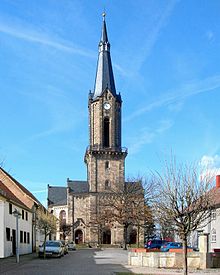St. Viti (Wechmar)
The Evangelical Lutheran listed church St. Viti in Wechmar , a district of the rural community Drei Gleichen in the district of Gotha is one of the largest village churches in Thuringia . The parish Wechmar is part of the parish area Muhlberg the region three of a kind in the church district Gotha of the Evangelical Church in Central Germany .
The church
The octagonal central building, built in natural stone masonry according to plans by the architect Kuhn , in a round arch style with a width of 26 m was inaugurated on November 7, 1843. In the east of the nave there is an annex with three arched portals , the walls of which are decorated in romanized forms. In the middle is the staircase , above which the 68 meter high church tower rises, a landmark of the community. Four church bells hang in the eight-sided high storey with the bell house , which is covered with a pointed helmet . One is from 1621. The nave and the church tower are structured by pilaster strips and arched friezes below the eaves .
history
Bonifatius , the apostle of the Thuringians, is said to have laid the foundation stone for the first church here in the 8th century. From 1354 to 1368 Peter Zinke is mentioned as the first priest in old chronicles . In 1467 the church was rebuilt in three construction phases. It became a parish church and received a relic of St. Veit and therefore her name. When the Reformation took hold of the place in 1524 , the pilgrimage of the Eichsfelder to Vierzehnheiligen - intermediate station Wechmar - was over: The relic landed with the atonement cross in the fire on the church square.
In 1652 the church received a new organ, and in 1664 the building was completely renovated. In 1681 the tower was damaged by fire, and in 1787 it was struck by lightning.
The spire was struck by lightning again on March 4, 1817 during a severe thunderstorm. Since the fire on the tower could not be extinguished due to insufficient water pressure in the fire hoses, courageous craftsmen sawed off the top of the tower. The subsequent derision of some citizens, especially the surrounding communities, ultimately led to the already dilapidated church being torn down in 1832.
Renovation work on the tower
When the leaky roof was to be repaired, an attempt was made to get half a million euros for the church renovation via the television program Ein Dorf wird haben. The village took second place in this competition and won 50,000 euros. The roof was re-covered with slate from the Moselle . The roof structure only needed to be partially repaired. In addition to the winnings, funds came from the sponsors: State of Thuringia (120,000 euros), Günthersleben-Wechmar municipality (60,000 euros), Hannover Church Building Foundation (50,000 euros), Gotha district church office (30,000 euros) and the parish and the Viti-Förderverein (20,000 euros each). After the roof, the masonry renovation was due.
Church interior
The interior is characterized by the surrounding galleries , a pulpit with pictures of Jesus and the four evangelists , the altar with crucifix , a baptismal font , the organ and various wall and glass pictures. The Sankt-Viti-Kirche houses the oldest glass picture from the 19th century in Thuringia. It shows the patron saint of the church, St. Vitus, the missionary Bonifatius and, in a colorful representation, the Count von Gleichen with his two wives. Below is the burning of the bull threatening the ban in Wittenberg from Luther's life . To the right and left of the glass window are paintings depicting Melanchthon and Luther, created by the Gotha court painter Jenichen in 1843 . The large pictures behind the altar come from the court painter Jacobsen from Gotha. They show the birth and resurrection of Christ.
A few furnishings have survived from before the Reformation , such as: B. the large crucifix and some old tombstones. The organ with 29 registers , divided into 2 manuals and pedal , was built in 1843 by Johann Friedrich Heinrich Ratzmann .
Churchyard
The churchyard is on the side of the nave. All legible gravestones are on grave sites from the 20th century. The grave of Herrmann Kerst is older. He was born on November 11, 1850 in the former rectory in Wechmar and at the age of 20 he went to the Franco-German War , where he died on September 2, 1870 in the Battle of Sedan as Vice Sergeant of the 15th Thuringian Infantry Regiment . His family planted a small oak tree on his grave and added a wooden cross. Over the years, the oak grew around the cross and "took" it. In 2012 the wooden cross was removed and replaced two years later. Today the oak is a symbol of peaceful coexistence in Wechmar as the peace oak .
gallery
- Pictures of the church
Church interior, the two paintings to the right and left of the glass window are by Paul Emil Jacobs
- Images of the cemetery
Gravestone of Arno Kalklösch and his family (publishing director and writer born in Wechmar)
literature
- Dehio-Handbuch der Deutschen Kunstdenkmäler, Thuringia. Deutscher Kunstverlag, Munich / Berlin 2003, ISBN 3-422-03095-6 . Page 1296
- Dirk Koch: Village churches around the three equals. Ed .: Trachtengruppe Ingersleben. Ingersleben 2006.
- Information brochure of the community Günthersleben-Wechmar 2009/2010.
Web links
Individual evidence
- ↑ St. Viti on EKMD
- ↑ In May 2010, the Thüringer Allgemeine , Gothaer edition of May 21, 2010 reported on the renovation work under the heading “The bathtub has had its day”
- ↑ Information on the organ
Coordinates: 50 ° 53 ′ 28.4 " N , 10 ° 46 ′ 27.2" E











